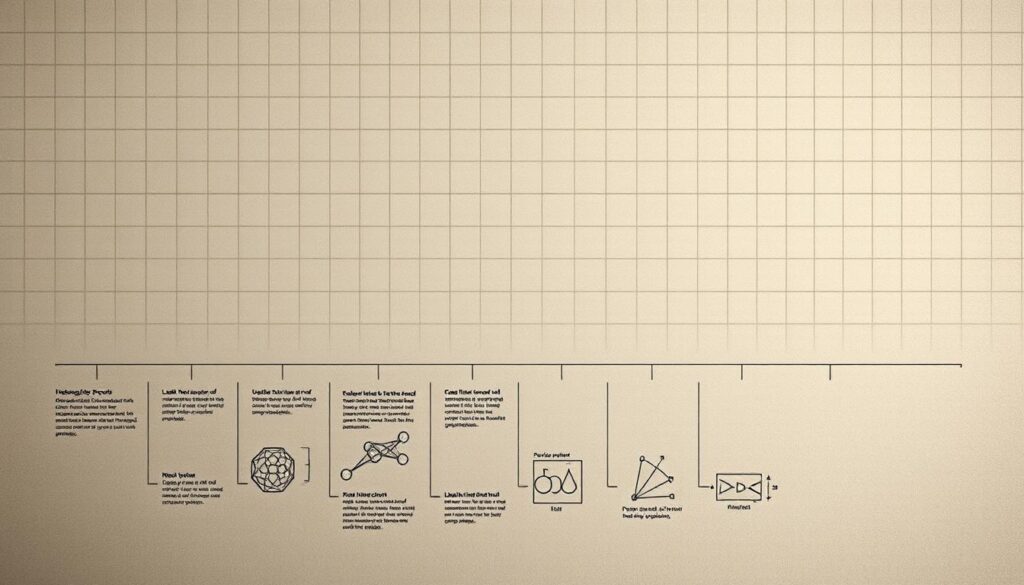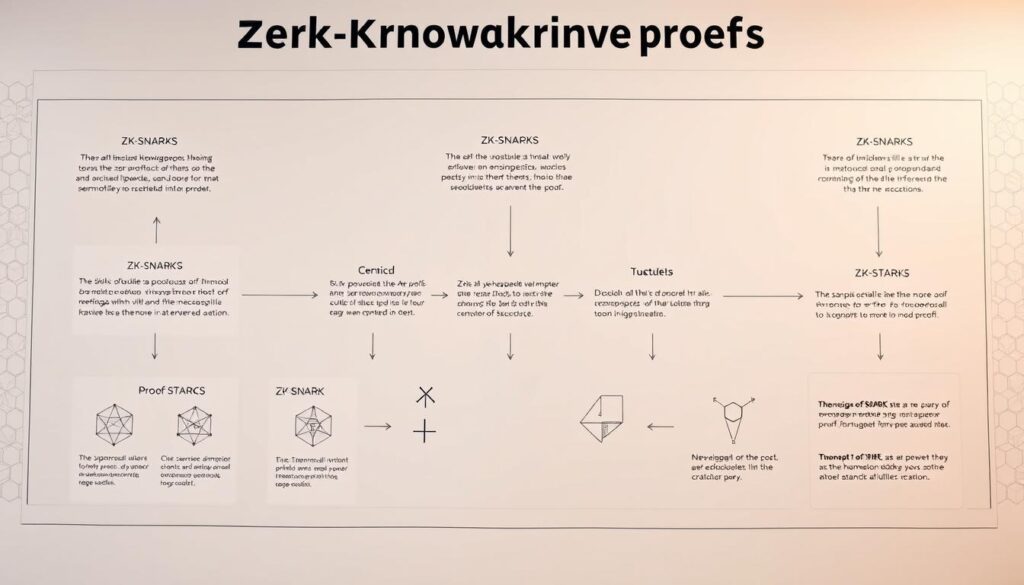In 1985, MIT researchers Shafi Goldwasser and Silvio Micali introduced a groundbreaking concept that would reshape digital security. Their work on interactive proof systems laid the foundation for protocols where one party can prove truthfulness to another without revealing sensitive details. This innovation now powers critical advancements in blockchain networks.
At its core, this method relies on three mathematical principles. Completeness ensures honest verification of valid claims. Soundness prevents deception through false statements. Most importantly, the zero-knowledge property maintains complete data confidentiality during verification. These features address the paradox of needing both transparency and privacy in digital transactions.
Modern blockchain applications leverage these protocols to validate operations while protecting user information. Systems using this approach allow participants to confirm transaction legitimacy through cryptographic verification rather than full data exposure. This balance makes the technology particularly valuable for privacy-focused systems requiring auditability.
The evolution from academic theory to real-world implementation demonstrates its growing importance. Developers now integrate these protocols into decentralized networks to enhance security without compromising speed. As digital assets become mainstream, understanding these verification mechanisms proves essential for anyone working with advanced blockchain solutions.
Key Takeaways
- Originated from 1985 MIT research on secure verification methods
- Three core principles ensure validity, security, and data protection
- Enables transaction confirmation without revealing sensitive details
- Critical for balancing transparency and privacy in digital systems
- Widely adopted in modern blockchain infrastructure
Introduction to Zero-Knowledge Concepts
Digital systems face a critical challenge: how to verify transactions while keeping sensitive details hidden. Cryptographic methods now exist that let users confirm information authenticity without exposing the actual data. This breakthrough reshapes how we approach security in connected environments.
Defining the Core Mechanism
At the heart of these systems lies a unique interaction between two parties. The prover demonstrates possession of specific knowledge, while the verifier checks its validity. Through mathematical protocols, both achieve certainty without revealing unnecessary details.
Consider a digital signature that proves account ownership without showing balances. Such interactions maintain privacy while preventing fraud. The system works because complex algorithms create trust through verification, not disclosure.
Why Privacy Matters Now
Modern networks handle sensitive data daily – from financial records to medical histories. Traditional validation methods often require full visibility, creating vulnerability points. Recent breaches highlight the urgent need for alternatives that protect user information.
These cryptographic methods solve this dilemma. They allow platforms to confirm actions like payments or logins while keeping personal details encrypted. As surveillance risks grow, such privacy-preserving tools become essential for safe digital participation.
The History and Fundamentals of Zero-Knowledge Proofs
Cryptographic innovation took a revolutionary turn in the mid-1980s when two researchers unveiled a method to verify truth without exposing secrets. Their work addressed a growing need for secure communication methods in an increasingly digital world.

Origins and Evolution in Cryptography
Shafi Goldwasser and Silvio Micali’s 1985 paper laid the groundwork for modern verification methods. Their concept of “knowledge complexity” measured how much information gets revealed during validation processes. This metric became vital for developing privacy-preserving systems.
Early adopters recognized these protocols could solve trust issues in digital interactions. Banks and governments began exploring ways to confirm transactions without compromising sensitive data. Over decades, academic refinements transformed theoretical models into practical tools.
Core Properties: Completeness, Soundness, and Zero-Knowledge
Three pillars uphold every effective verification method. Completeness guarantees honest validators accept truthful claims. A properly constructed proof always convinces those following protocol rules.
Soundness acts as a fraud prevention mechanism. Dishonest parties can’t fake validation through clever wording or technical tricks. This ensures only legitimate statements pass verification checks.
The namesake feature ensures zero-knowledge exchange. Validators learn nothing beyond the claim’s truthfulness, keeping original data fully protected. Together, these principles create trust without transparency trade-offs.
Demystifying Zero-Knowledge with Practical Examples
Imagine proving you know a secret without whispering a single clue. The cave analogy demonstrates this paradox perfectly. Picture a circular cavern with two paths meeting at a magic door. Alice knows the password but needs to convince Bob without sharing it.

The Cave Analogy Explained
Here’s how it works: Bob waits outside while Alice enters through either path. When she reaches the door, Bob shouts a random exit path. If Alice knows the password, she’ll always return correctly – even if Bob picks the opposite route. Repeat this 10 times, and the odds of guessing right drop to 1 in 1,024.
This mirrors how provers validate transactions without revealing sensitive details. Each successful round builds mathematical confidence. After multiple challenges, the verifier gains certainty without ever seeing the secret.
Interactive vs. Non-Interactive Proof Schemes
Two main approaches exist for these validations:
- Interactive proofs require real-time back-and-forth like the cave example
- Non-interactive proofs generate one-time validations usable by anyone
Blockchain networks favor non-interactive methods for efficiency. A single proof can verify thousands of transactions simultaneously. This eliminates repetitive checks while maintaining ironclad data protection – crucial for scaling decentralized systems.
Both methods share one core strength: enabling trust through cryptographic certainty rather than data exposure. As digital interactions grow more complex, these principles become vital tools for secure verification.
Types of Zero-Knowledge Proofs and Their Use Cases
Blockchain systems demand verification methods that protect sensitive details while ensuring validity. Four main approaches dominate this space, each balancing speed, security, and resource requirements.

zk-SNARKs and Their Advantages
zk-SNARKs (Succinct Non-Interactive Arguments of Knowledge) use elliptical curves to create compact proofs. These require minimal storage and verify quickly – perfect for networks with limited computing power. Their gas efficiency makes them popular in Ethereum-based applications.
A key trade-off involves the initial “trusted setup” phase. While this process enhances security, it demands careful execution to prevent vulnerabilities. Developers often use these proofs for private transactions in payment networks.
zk-STARKs and Bulletproofs
zk-STARKs eliminate trusted setups through hash functions, improving transparency. They handle larger datasets faster than SNARKs and resist quantum computing threats. This makes them ideal for platforms requiring audit trails.
Bulletproofs specialize in confidential transactions without setup requirements. Their short proof size suits privacy coins needing frequent verifications. Unlike SNARKs, they avoid complex math operations, reducing processing overhead.
| Type | Proof Size | Setup | Speed | Best For |
|---|---|---|---|---|
| zk-SNARK | Small | Trusted | Fast Verify | Low-power networks |
| zk-STARK | Larger | None | Fast Prove | Big datasets |
| Bulletproof | Medium | None | Balanced | Private payments |
| PLONK | Variable | Universal | Flexible | Multi-chain systems |
PLONK protocols stand out with reusable trusted setups. This “universal” approach lets developers apply the same configuration across multiple applications. Financial platforms benefit from this flexibility when handling cross-chain operations.
Exploring zero knowledge proof technology in cryptocurrency

Financial systems are undergoing a silent revolution through advanced cryptographic methods. Networks like Zcash demonstrate how transactions can validate authenticity while keeping amounts and addresses hidden. This approach resolves blockchain’s transparency paradox – maintaining auditability without exposing sensitive details.
Businesses now leverage these systems to meet strict privacy regulations. Healthcare platforms use them to process payments while protecting patient records. Financial institutions verify transactions through encrypted proofs rather than sharing account balances publicly.
| Application | Benefit | Implementation |
|---|---|---|
| Private Payments | Hidden sender/receiver | Zcash shielded pools |
| Smart Contracts | Confidential terms | Enterprise Ethereum |
| Regulatory Compliance | Selective disclosure | Banking integrations |
| DeFi Protocols | Secure lending | Collateral verification |
Decentralized finance platforms benefit significantly from these innovations. Lending services confirm collateral adequacy without revealing wallet contents. This prevents targeted attacks while ensuring protocol security.
Institutional adoption grows as companies protect trade secrets during blockchain interactions. Manufacturers share supply chain data through smart contracts that hide proprietary formulas. These developments bridge traditional finance expectations with decentralized systems’ capabilities.
Zero-Knowledge Proofs in Blockchain Networks and Layer 2 Solutions
Blockchain scaling solutions have reached a critical juncture, balancing speed with robust security. Layer 2 systems now employ advanced methods to process transactions efficiently while maintaining network integrity.
Understanding ZK-Rollups
ZK-Rollup systems batch hundreds of transfers into single operations. By generating cryptographic proofs off-chain, they reduce congestion while keeping base layers secure. These validity confirmations – whether SNARKs or STARKs – act as digital notaries for bundled actions.
Exploring Validium and Volitions
Validium networks take a different approach by storing data off-chain entirely. This boosts throughput but requires trust in external providers. Hybrid models like Volitions let users choose between on-chain verification or third-party storage for flexibility.
Each solution addresses specific needs in decentralized ecosystems. Some prioritize absolute security through blockchain anchoring, while others optimize speed through alternative data handling. As adoption grows, these tools reshape how networks manage growth without compromising core principles.


No comments yet